Efficiency Comparison of DC and AC Coupling Solutions for Large-Scale PV+BESS Power Plants
Abstract
:1. Introduction
2. The Case Study: A 288 MW PV Plant with 92.2 MW/275.2 MWh Integrated BESS
3. BESS Coupling Topologies
3.1. AC-Coupling
3.2. DC-Coupling/BESS-Side
3.3. DC-Coupling/PV-Side
4. Plant’s Power Flows Analysis
4.1. Primary Frequency Reserve Operation and BESS Charging
4.2. Discharging Strategy of the BESS
5. Plant’s Loss and Efficiency Calculation
6. Results and Discussion
7. Conclusions
Author Contributions
Funding
Data Availability Statement
Conflicts of Interest
Appendix A
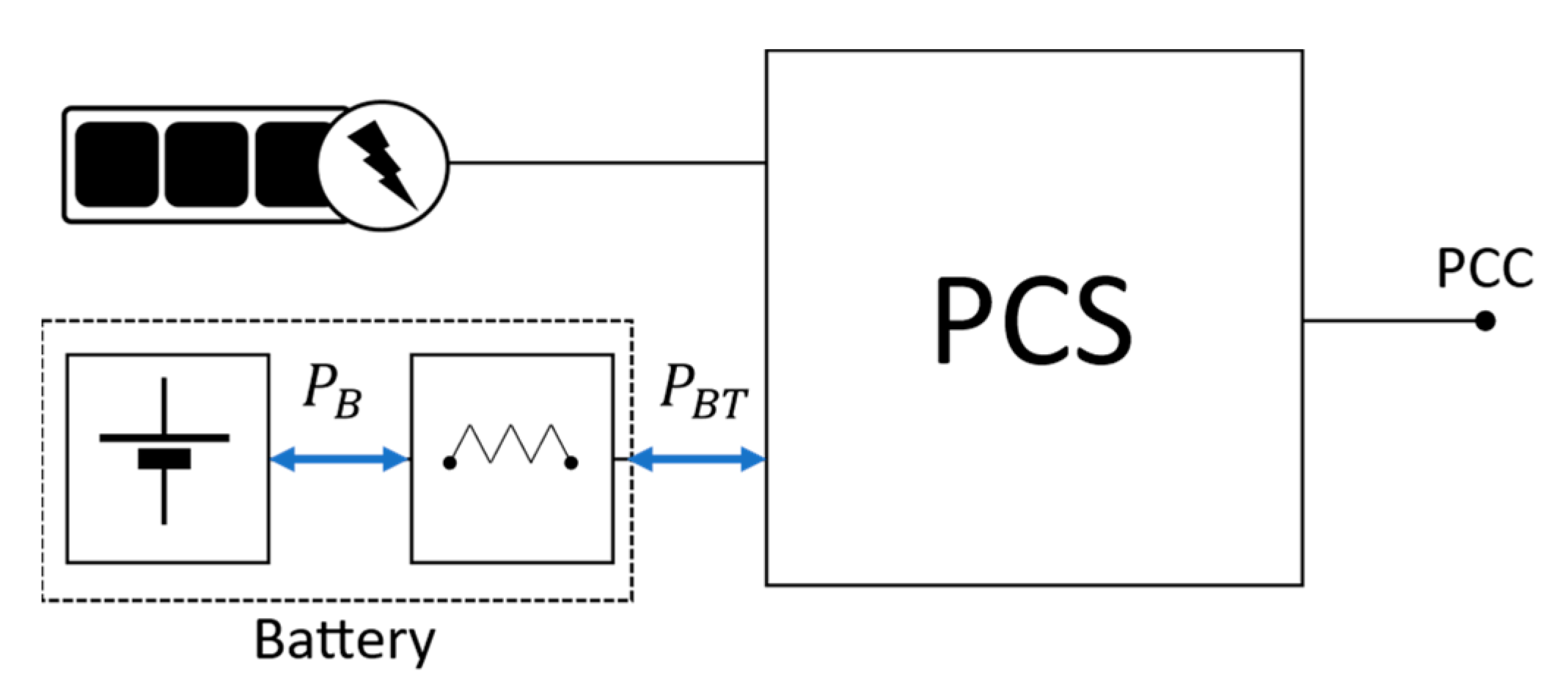
| PCS+BESS Efficiency | ||||
|---|---|---|---|---|
| Battery Round Trip Efficiency | AC-Coupling | DC/BESS Coupling | DC/PV Coupling | Average C-Rate (LiFePO) |
| 100% | 96.86% | 97.02% | 96.34% | ≤0.25 C |
| 98% | 96.75% | 96.92% | 96.24% | |
| 95% | 96.56% | 96.71% | 96.05% | 0.25 < C-rate ≤ 4 |
| 90% | 96.22% | 96.37% | 95.75% | |
| 85% | 95.89% | 96.03% | 95.44% | |
| 80% | 95.56% | 95.69% | 95.14% | >4 C |
References
- Liu, X.; Aichhorn, A.; Liu, L.; Li, H. Coordinated control of distributed energy storage system with tap changer transformers for voltage rise mitigation under high photovoltaic penetration. IEEE Trans. Smart Grid 2012, 3, 897–906. [Google Scholar] [CrossRef]
- Luo, C.; Ooi, B.T. Frequency deviation of thermal power plants due to wind farms. IEEE Trans. Energy Convers. 2006, 21, 708–716. [Google Scholar] [CrossRef]
- Kroposki, B.; Johnson, B.; Zhang, Y.; Gevorgian, V.; Denholm, P.; Hodge, B.M.; Hannegan, B. Achieving a 100% renewable grid: Operating electric power systems with extremely high levels of variable renewable energy. IEEE Power Energy Mag. 2017, 15, 61–73. [Google Scholar] [CrossRef]
- Chamana, M.; Chowdhury, B.H.; Jahanbakhsh, F. Distributed control of voltage regulating devices in the presence of high PV penetration to mitigate ramp-rate issues. IEEE Trans. Smart Grid 2018, 9, 1086–1095. [Google Scholar] [CrossRef]
- Datta, U.; Kalam, A.; Shi, J. Battery energy storage system control for mitigating PV penetration impact on primary frequency control and state-of-charge recovery. IEEE Trans. Sustain. Energy 2020, 11, 746–757. [Google Scholar] [CrossRef] [Green Version]
- Gevorgian, V.; O’Neill, B. Advanced Grid-Friendly Controls Demonstration Project for Utility-Scale PV Power Plants; NREL: Golden, CO, USA, 2016. [Google Scholar]
- Gevorgian, V.; Booth, S. Review of PREPA Technical Requirements for Interconnecting Wind and Solar Generation; NREL: Golden, CO, USA, 2013. [Google Scholar]
- Loutan, C.; Klauer, P.; Chowdhury, S.; Hall, S.; Morjaria, M.; Chadliev, V.; Milam, N.; Milan, C.; Gevorgian, V. Demonstration of Essential Reliability Services by a 300-MW Solar Photovoltaic Power Plant; NREL: Golden, CO, USA, 2017. [Google Scholar]
- Miller, N.; Manz, D.; Roedel, J.; Marken, P.; Kronbeck, E. Utility scale battery energy storage systems. In Proceedings of the IEEE PES General Meeting, PES 2010, Minneapolis, MN, USA, 26 July 2010; pp. 1–7. [Google Scholar]
- Muñoz-Cruzado-Alba, J.; Rojas, C.; Kouro, S.; Galván Díez, E. Power production losses study by frequency regulation in weak-grid-connected utility-scale photovoltaic plants. Energies 2016, 9, 317. [Google Scholar] [CrossRef] [Green Version]
- Díaz-González, F.; Sumper, A.; Gomis-Bellmunt, O. Energy Storage in Power Systems; Díaz-González, F., Sumper, A., Gomis-Bellmunt, O., Eds.; John Wiley & Sons Ltd.: Chichester, UK, 2016; ISBN 9781118971291. [Google Scholar]
- Han, Z.; Luo, G.; Song, X.; Yang, C.; Zhang, L.; Jia, Y.; Zhao, Z.; Jin, Y. Research on the dispatch proportion of battery capacity in photovoltaic primary frequency control. In Proceedings of the 2019 3rd IEEE Conference on Energy Internet and Energy System Integration: Ubiquitous Energy Network Connecting Everything, Changsha, China, 8–10 November 2019; Institute of Electrical and Electronics Engineers: Piscataway, NJ, USA, 2019; pp. 1098–1103. [Google Scholar]
- Barchi, G.; Pierro, M.; Moser, D. Predictive energy control strategy for peak shaving and shifting using BESS and PV generation applied to the retail sector. Electronics 2019, 8, 526. [Google Scholar] [CrossRef] [Green Version]
- Solar Power Europe. Grid Intelligent Solar Unleashing the Full Potential of Utility-Scale Solar Generation in Europe; Solar Power Europe: Brussels, Belgium, 2019. [Google Scholar]
- International Renewable Energy Agency. Utility-Scale Batteries Innovation Landscape Brief; International Renewable Energy Agency: Abu Dhabi, United Arab Emirates, 2019; ISBN 978-92-9260-139-3. [Google Scholar]
- Abdelrazek, S.A.; Kamalasadan, S. Integrated PV capacity firming and energy time shift battery energy storage management using energy-oriented optimization. IEEE Trans. Ind. Appl. 2016, 52, 2607–2617. [Google Scholar] [CrossRef]
- Ahmed, M.; Kamalasadan, S. Energy storage PV capacity firming with forecasted power reference and optimal error minimization. In Proceedings of the 2015 North American Power Symposium, Charlotte, NC, USA, 4–6 October 2015; Institute of Electrical and Electronics Engineers: Piscataway, NJ, USA, 2015; pp. 1–6. [Google Scholar]
- Yang, Y.; Kim, K.A.; Blaabjerg, F.; Sangwongwanich, A. Flexible active power control of PV systems. In Advances in Grid-Connected Photovoltaic Power Conversion Systems; Elsevier: Amsterdam, The Netherlands, 2019; pp. 153–185. [Google Scholar]
- Denholm, P.; Eichman, J.; Margolis, R. Evaluating the Technical and Economic Performance of PV Plus Storage Power Plants; NREL: Golden, CO, USA, 2017. [Google Scholar]
- Dynapower AC vs. DC Coupling for Solar Plus Energy Storage Projects|Dynapower. Available online: https://www.dynapower.com/ac-vs-dc-coupled-solar-plus-storage/ (accessed on 27 January 2021).
- Go Big, Go DC: An In-Depth Look at DC-Coupled Solar-Plus-Storage|Energy Storage News. Available online: https://www.energy-storage.news/blogs/go-big-go-dc-an-in-depth-look-at-dc-coupled-solar-plus-storage (accessed on 27 January 2021).
- Fluence a Battery for Hire: AC vs. DC Coupling for Solar + Energy Storage Projects. Available online: https://blog.fluenceenergy.com/energy-storage-ac-dc-coupled-solar (accessed on 27 January 2021).
- Sterling & Wilson why Large-Scale Solar Alone no Longer Makes Sense. Available online: https://www.pv-magazine.com/webinars/why-large-scale-solar-alone-no-longer-makes-sense/ (accessed on 27 January 2021).
- DiOrio, N.; Denholm, P.; Hobbs, W.B. A model for evaluating the configuration and dispatch of PV plus battery power plants. Appl. Energy 2020, 262, 114465. [Google Scholar] [CrossRef]
- He, J.; Yang, Y.; Vinnikov, D. Energy storage for 1500 V photovoltaic systems: A comparative reliability analysis of DC- and AC-coupling. Energies 2020, 13, 3355. [Google Scholar] [CrossRef]
- Sandelic, M.; Sangwongwanich, A.; Blaabjerg, F. Reliability evaluation of PV systems with integrated battery energy storage systems: DC-coupled and AC-coupled configurations. Electronics 2019, 8, 1059. [Google Scholar] [CrossRef] [Green Version]
- Despeghel, J.; Tant, J.; Driesen, J. Loss model for improved efficiency characterization of DC coupled PV-battery system converters. In Proceedings of the IECON Proceedings (Industrial Electronics Conference), Lisbon, Portugal, 14–17 October 2019; IEEE Computer Society: Washington, DC, USA, 2019; pp. 4740–4745. [Google Scholar]
- Akeyo, O.; Rallabandi, V.; Jewell, N.; Ionel, D.M. The design and analysis of large solar PV farm configurations with DC-connected battery systems. IEEE Trans. Ind. Appl. 2020, 56, 2903–2912. [Google Scholar] [CrossRef]
- Müller, N.; Kouro, S.; Zanchetta, P.; Wheeler, P.; Bittner, G.; Girardi, F. Energy storage sizing strategy for grid-tied PV plants under power clipping limitations. Energies 2019, 12, 1812. [Google Scholar] [CrossRef] [Green Version]
- Central Inverter PVS980-58. Available online: https://www.fimer.com/sites/default/files/FIMER_PVS980-58-from4348to5000_EN_RevB__0.pdf (accessed on 24 May 2021).
- Asian Development Bank. Handbook on Battery Energy Storage System; Asian Development Bank: Mandaluyong, Philippines, 2018; ISBN 9789292614706. [Google Scholar]
- HITACHI ABB Battery Energy Storage System PQpluSTM. Available online: https://www.hitachiabb-powergrids.com/it/it/offering/product-and-system/energystorage/pqplus (accessed on 3 July 2021).
- World Bank Group Economic Analysis of Battery Energy Storage Systems. Available online: https://openknowledge.worldbank.org/bitstream/handle/10986/33971/Economic-Analysis-of-Battery-Energy-Storage-Systems.pdf?sequence=1&isAllowed=y (accessed on 3 July 2021).
- ITP Renewables Reports—Lithium Ion Battery Test Centre. Available online: https://batterytestcentre.com.au/reports/ (accessed on 3 July 2021).
- Kosmadakis, I.E.; Elmasides, C.; Koulinas, G.; Tsagarakis, K.P. Energy unit cost assessment of six photovoltaic-battery configurations. Renew. Energy 2021, 173, 24–41. [Google Scholar] [CrossRef]
- Susanto, J.; Shahnia, F.; Ludwig, D. A framework to technically evaluate integration of utility-scale photovoltaic plants to weak power distribution systems. Appl. Energy 2018, 231, 207–221. [Google Scholar] [CrossRef]
- European Network of Transmission System Operators for Electricity (ENTSO-E). Inertia and Rate of Change of Frequency (RoCoF); European Network of Transmission System Operators for Electricity (ENTSO-E): Brussels, Belgium, 2020. [Google Scholar]
- Puerto Rico Electric Power Authority’s Minimum Technical Renewables Interconnection Requirements—ESIG. Available online: https://www.esig.energy/wiki-main-page/puerto-rico-electric-power-authority-s-minimum-technical-renewables-interconnection-requirements/#Frequency_Response.2FRegulationRegulation (accessed on 27 January 2021).
- Denholm, P.; O’Connell, M.; Brinkman, G.; Jorgenson, J. Overgeneration from Solar Energy in California: A Field Guide to the Duck Chart; NREL: Golden, CO, USA, 2015. [Google Scholar]
- Mathews, I.; Xu, B.; He, W.; Barreto, V.; Buonassisi, T.; Peters, I.M. Technoeconomic model of second-life batteries for utility-scale solar considering calendar and cycle aging. Appl. Energy 2020, 269, 115127. [Google Scholar] [CrossRef]
- Stieneker, M.; Mortimer, B.J.; Averous, N.R.; Stagge, H.; de Doncker, R.W. Optimum design of medium-voltage DC collector grids depending on the offshore-wind-park power. In Proceedings of the PEMWA 2014—2014 IEEE Symposium on Power Electronics and Machines for Wind and Water Applications, Milwaukee, WI, USA, 24–26 July 2014; Institute of Electrical and Electronics Engineers: Piscataway, NJ, USA, 2014; pp. 1–8. [Google Scholar]
- Morandi, A.; Gholizad, B.; Stieneker, M.; Stagge, H.; de Doncker, R.W. Technical and economical evaluation of DC high-temperature superconductor solutions for the grid connection of offshore wind parks. IEEE Trans. Appl. Supercond. 2016, 26, 1–10. [Google Scholar] [CrossRef]
- Italweber Electra General Catalougue. Available online: www.italweberelettra.it (accessed on 27 January 2021).
- Stan, A.I.; Swierczynski, M.; Stroe, D.I.; Teodorescu, R.; Andreasen, S.J.; Moth, K. A comparative study of lithium ion to lead acid batteries for use in UPS applications. In Proceedings of the INTELEC, International Telecommunications Energy Conference, Vancuver, BC, USA, 28 September–2 October 2014; Institute of Electrical and Electronics Engineers: Piscataway, NJ, USA, 2014; pp. 1–8. [Google Scholar]
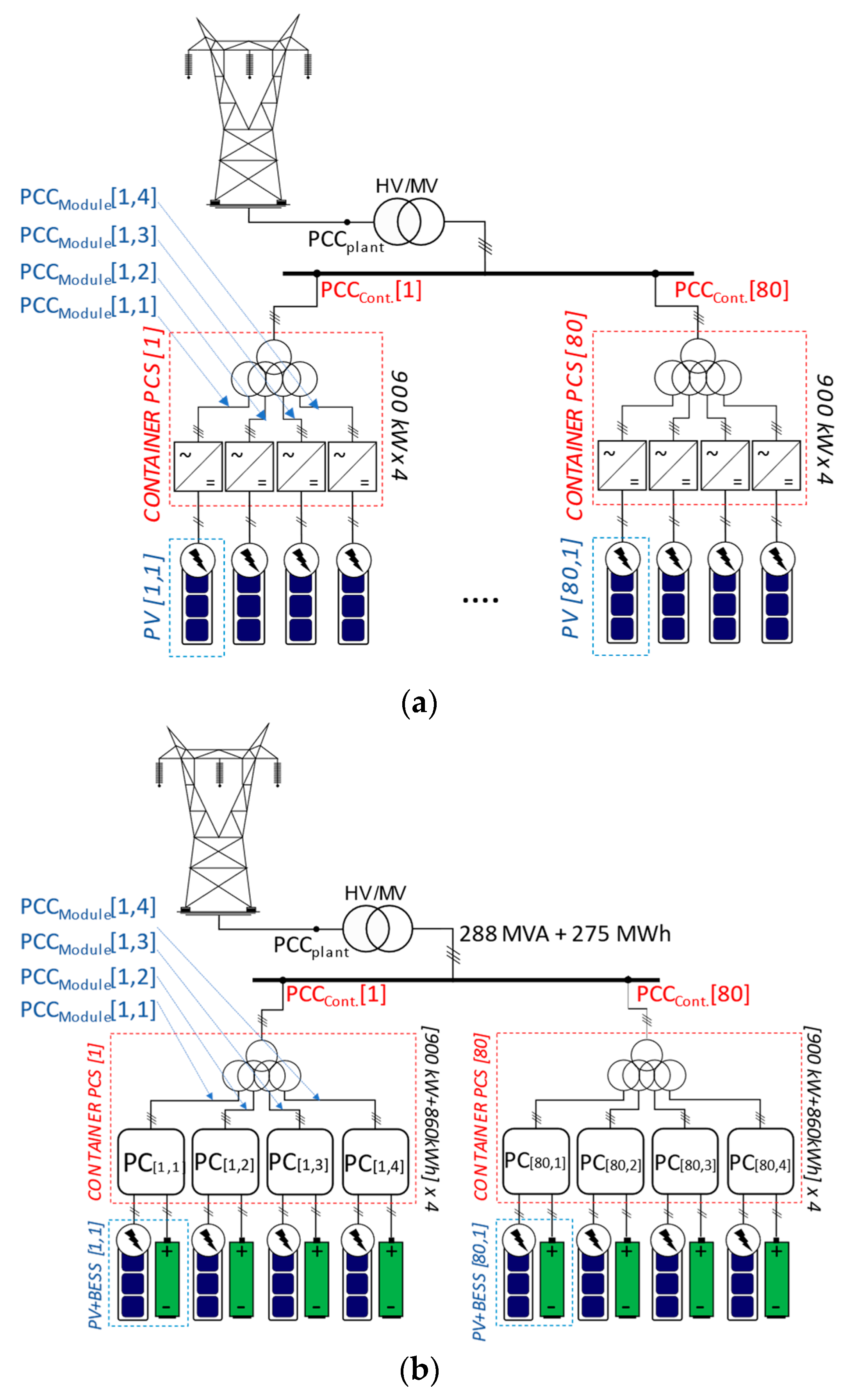



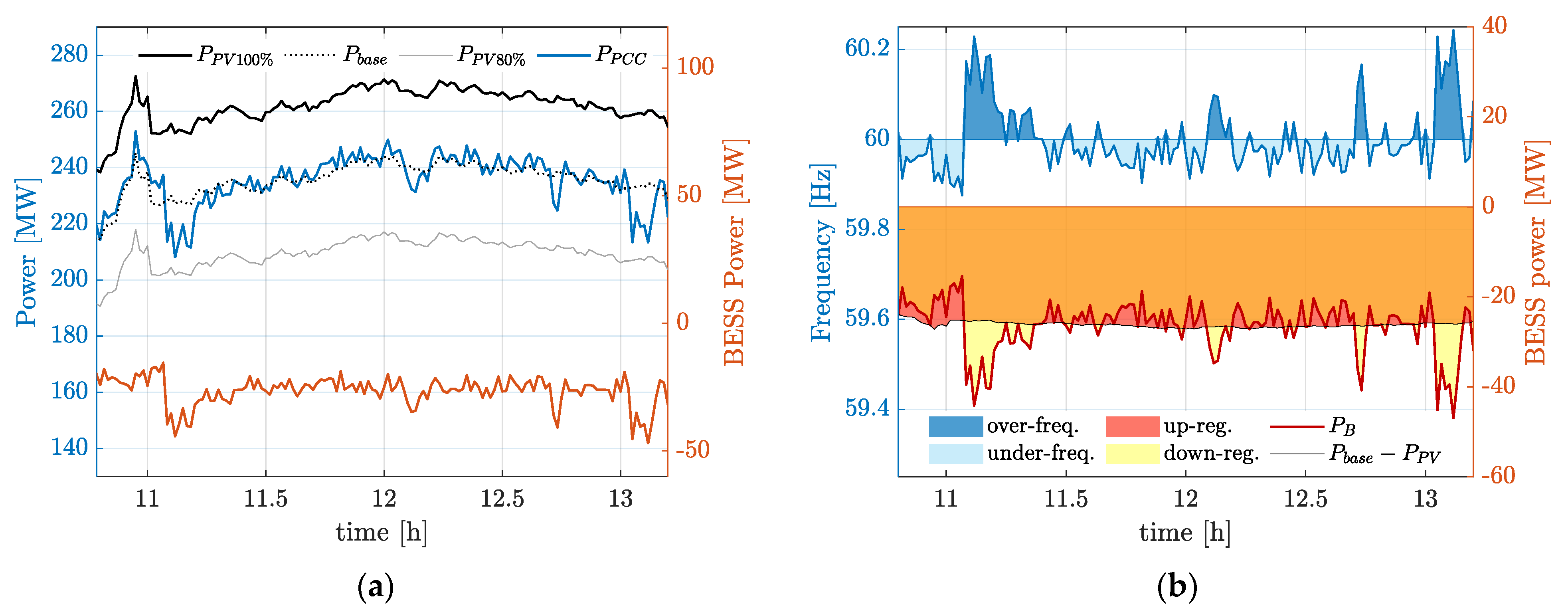

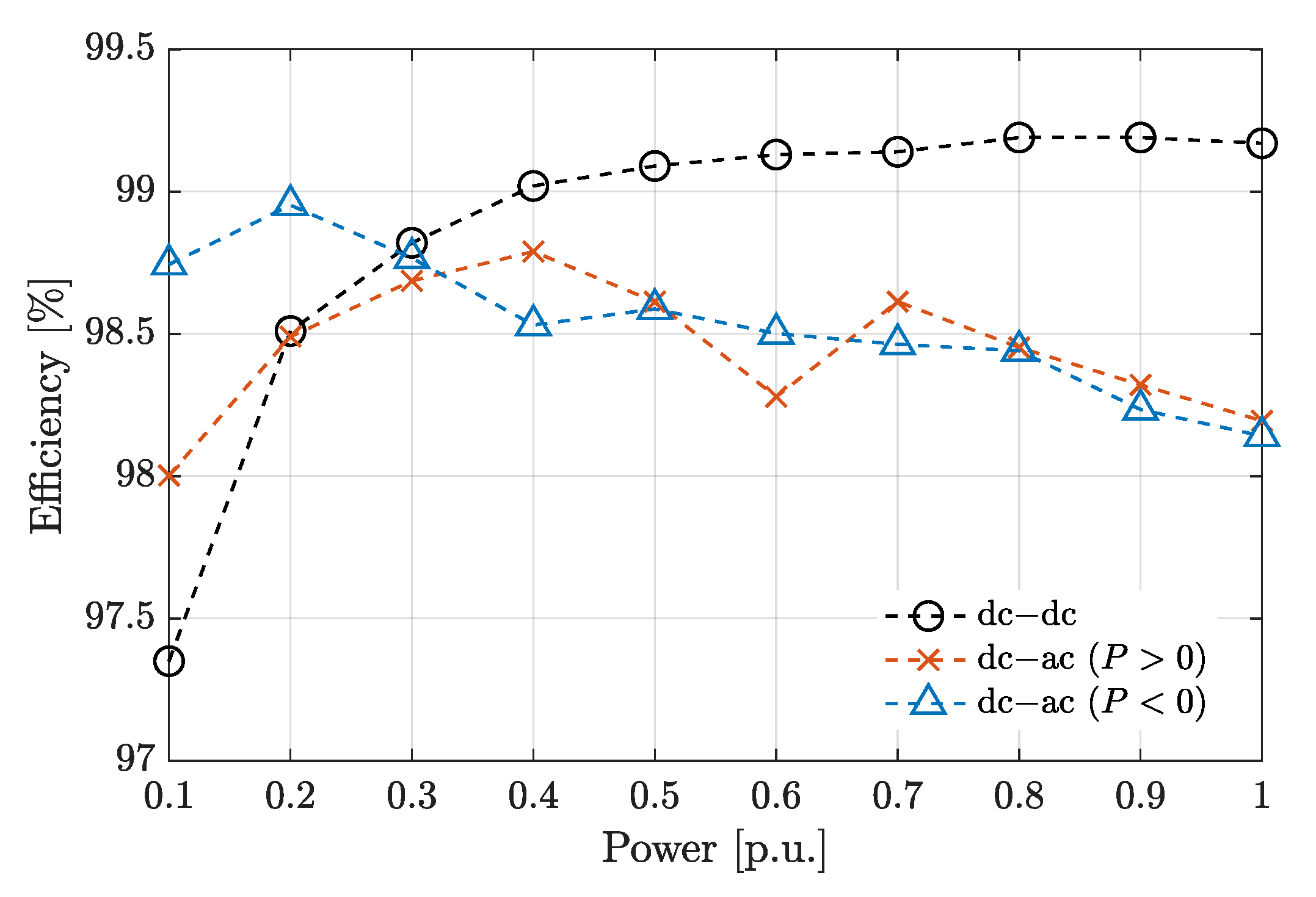
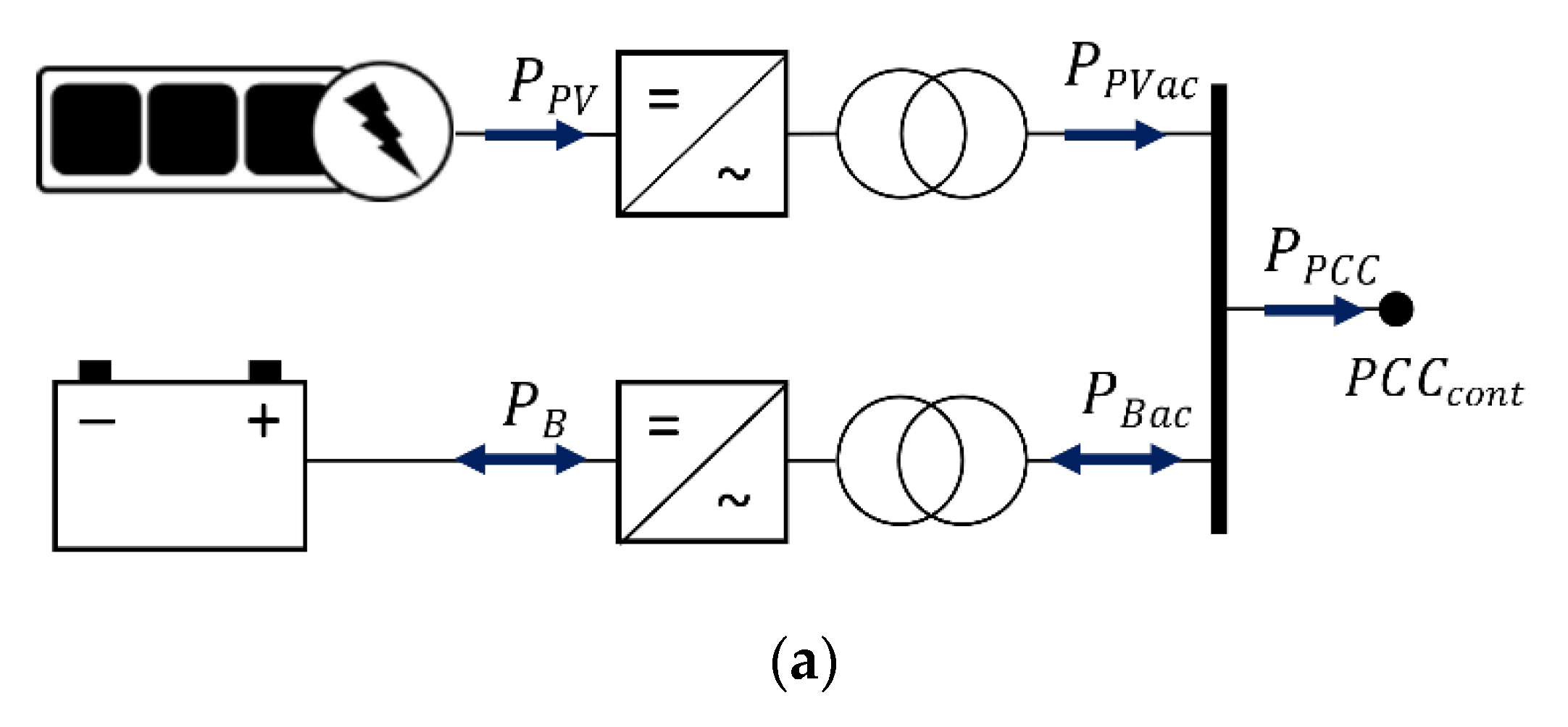


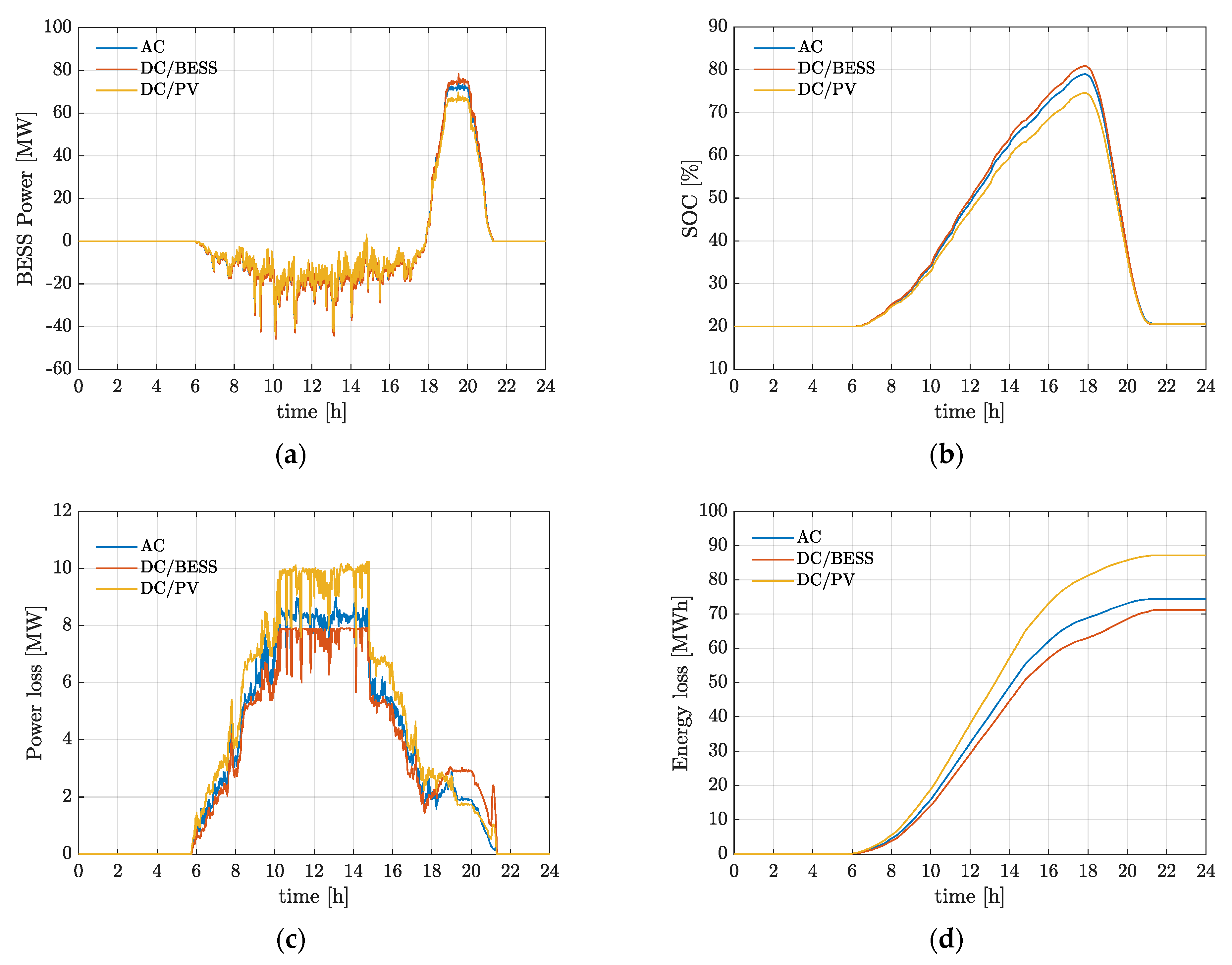
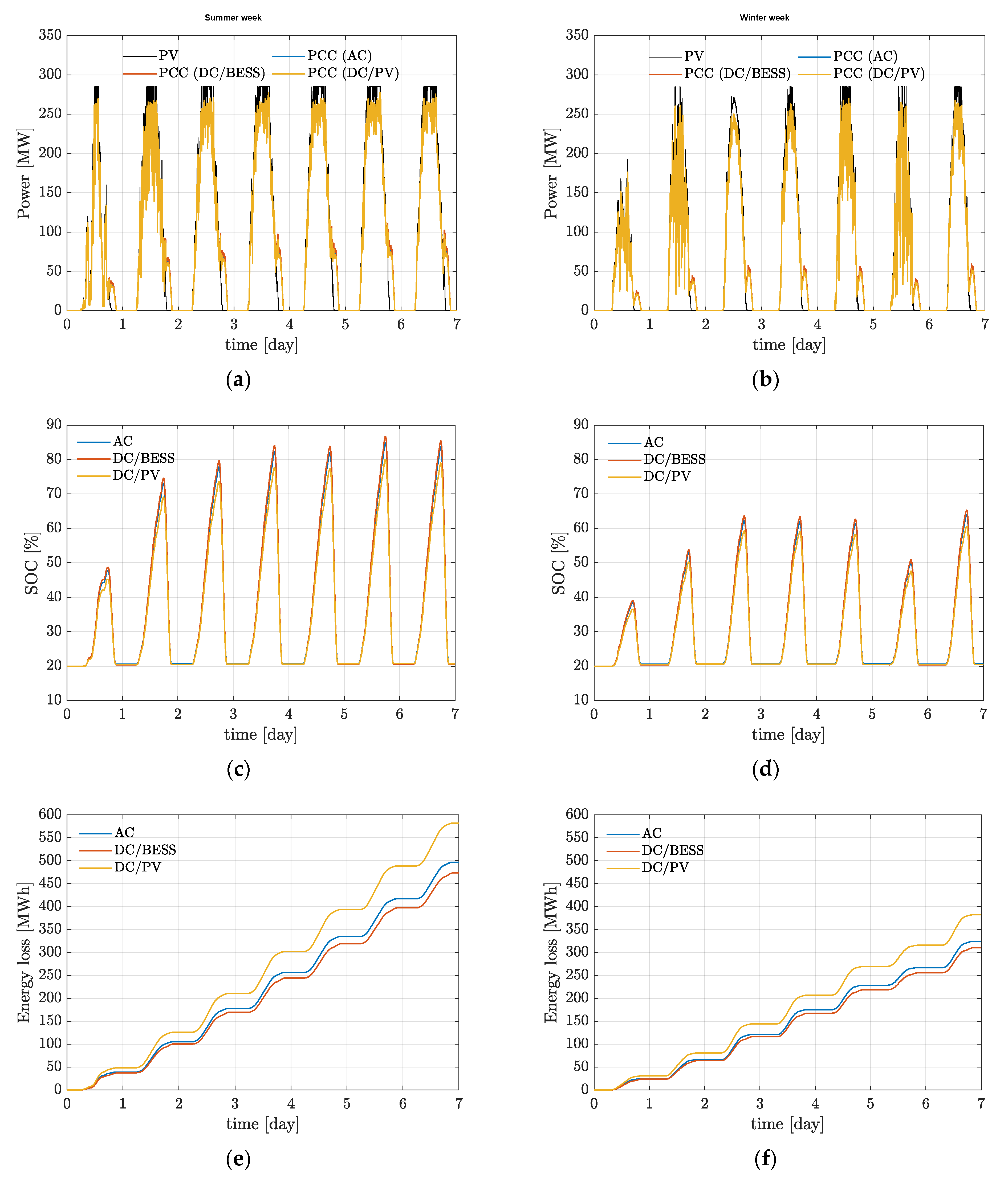
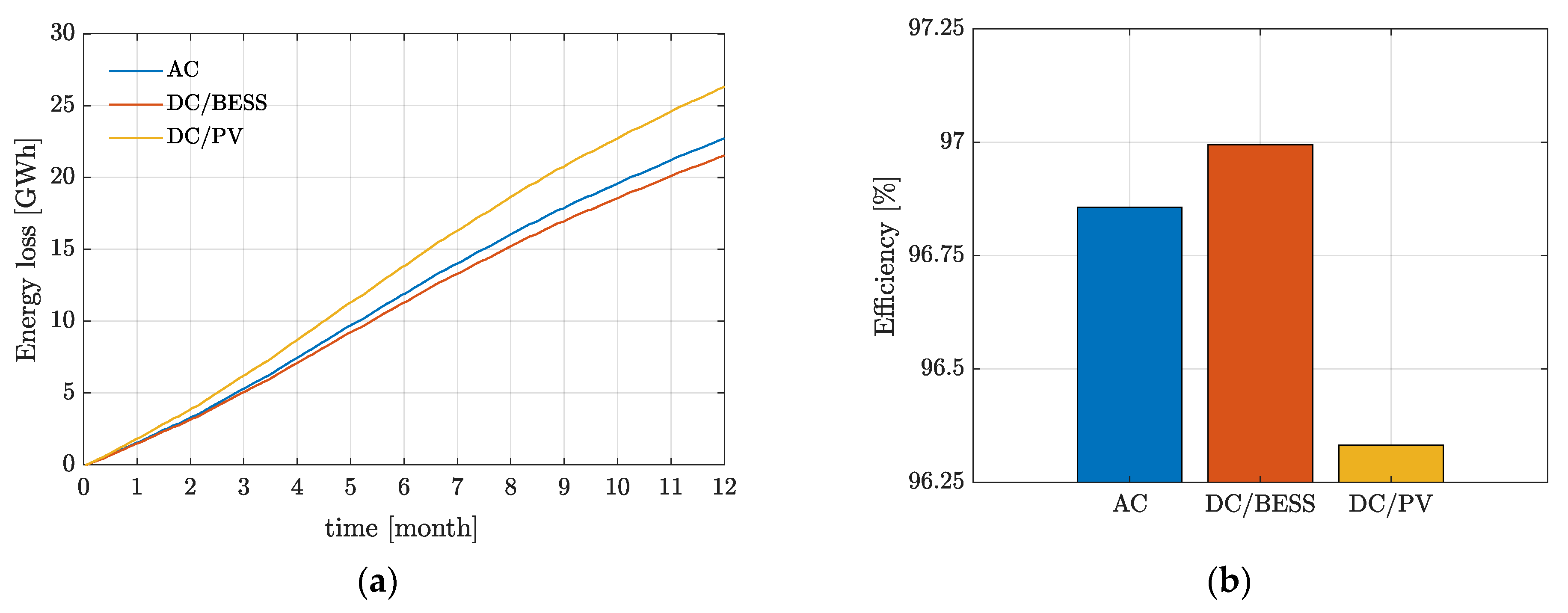
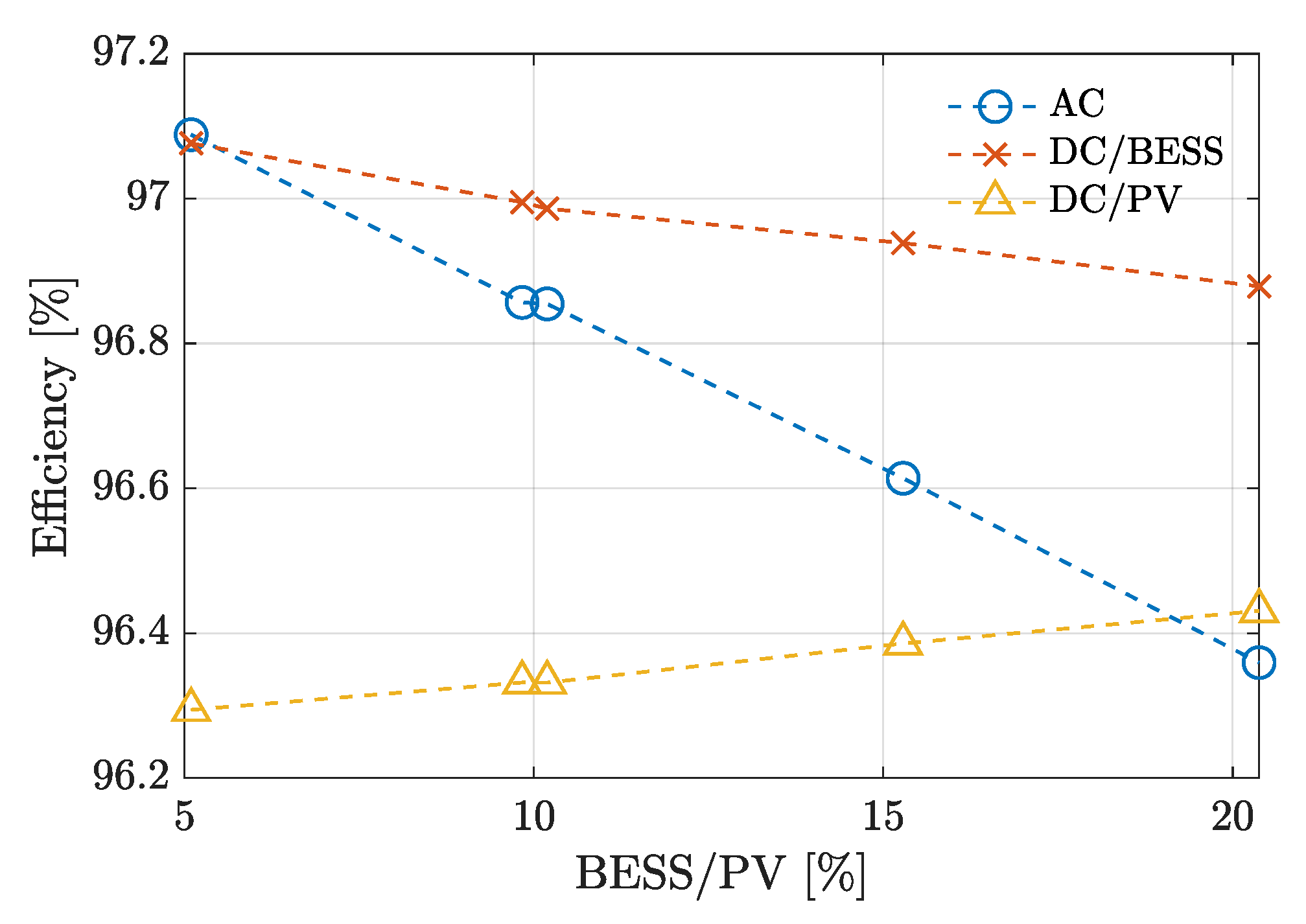
| Single Module | Total Plant (320 Modules) | ||||||
|---|---|---|---|---|---|---|---|
| Layout | AC | DC–BESS | DC–PV | AC | DC–BESS | DC–PV | |
| PV | [MW] | 0.900 | 0.900 | 0.900 | 288 | 288 | 288 |
| BESS (energy) | [MWh] | 0.860 | 0.860 | 0.860 | 275.2 | 275.2 | 275.2 |
| BESS (power) | [MW] | 0.288 | 0.288 | 0.288 | 92.2 | 92.2 | 92.2 |
| transf. | [MVA] | 1.200 | 1.200 | 1.200 | 384 | 384 | 384 |
| BESS-transf. | [MVA] | 0.400 | - | - | 128 | - | - |
| inverter | [MVA] | 0.900 | 0.900 | 0.900 | 288 | 288 | 288 |
| BESS-inverter | [MVA] | 0.288 | - | - | 92.2 | - | - |
| dc–dc conv. | [MW] | - | 0.288 | 0.900 | - | 92.2 | 288 |
| AC-Coupling | DC-Coupling (BESS) | DC Coupling (PV) | ||||
|---|---|---|---|---|---|---|
| Power Flow | N° Conv. Stages | Path Efficiency | N° Conv. Stages | Path Efficiency | N° Conv. Stages | Path Efficiency |
| from PV to Grid | 2 | 2 | 3 | |||
| From PV to BESS | 4 | 1 | 1 | |||
| From BESS to grid | 2 | 3 | 2 | |||
| Low-Irradiance | Mean-Irradiance | High-Irradiance | |||||||
|---|---|---|---|---|---|---|---|---|---|
| AC | DC/BESS | DC/PV | AC | DC/BESS | DC/PV | AC | DC/BESS | DC/PV | |
| 779.8 | 1957.9 | 2398.1 | |||||||
| 753.6 | 754.9 | 747.6 | 1894.2 | 1897.4 | 1884.3 | 2312.0 | 2316.5 | 2300.5 | |
| −1.6 | −0.9 | −1.2 | −2.2 | −1.5 | −1.8 | −12.5 | −11.4 | −10.8 | |
| 24.5 | 23.9 | 31.01 | 61.5 | 58.9 | 71.7 | 73.6 | 79.1 | 86.7 | |
| η | 96.8% | 96.9% | 96.0% | 96.8% | 97.0% | 96.3% | 96.9% | 97.1% | 96.4% |
| PV Rating [MWp] | PV Energy [MWh/Day] | BESS/PV [%] | PFR Reserve | |
|---|---|---|---|---|
| 550 | 3916 | 5 | 95 | ±5 |
| 288 | 1958 | 9.8 | 90 | ±10 |
| 275 | 1869 | 10 | 90 | ±10 |
| 183 | 1305 | 15.3 | 85 | ±15 |
| 137 | 979 | 20.4 | 80 | ±20 |
Publisher’s Note: MDPI stays neutral with regard to jurisdictional claims in published maps and institutional affiliations. |
© 2021 by the authors. Licensee MDPI, Basel, Switzerland. This article is an open access article distributed under the terms and conditions of the Creative Commons Attribution (CC BY) license (https://creativecommons.org/licenses/by/4.0/).
Share and Cite
Lo Franco, F.; Morandi, A.; Raboni, P.; Grandi, G. Efficiency Comparison of DC and AC Coupling Solutions for Large-Scale PV+BESS Power Plants. Energies 2021, 14, 4823. https://doi.org/10.3390/en14164823
Lo Franco F, Morandi A, Raboni P, Grandi G. Efficiency Comparison of DC and AC Coupling Solutions for Large-Scale PV+BESS Power Plants. Energies. 2021; 14(16):4823. https://doi.org/10.3390/en14164823
Chicago/Turabian StyleLo Franco, Francesco, Antonio Morandi, Pietro Raboni, and Gabriele Grandi. 2021. "Efficiency Comparison of DC and AC Coupling Solutions for Large-Scale PV+BESS Power Plants" Energies 14, no. 16: 4823. https://doi.org/10.3390/en14164823
APA StyleLo Franco, F., Morandi, A., Raboni, P., & Grandi, G. (2021). Efficiency Comparison of DC and AC Coupling Solutions for Large-Scale PV+BESS Power Plants. Energies, 14(16), 4823. https://doi.org/10.3390/en14164823










